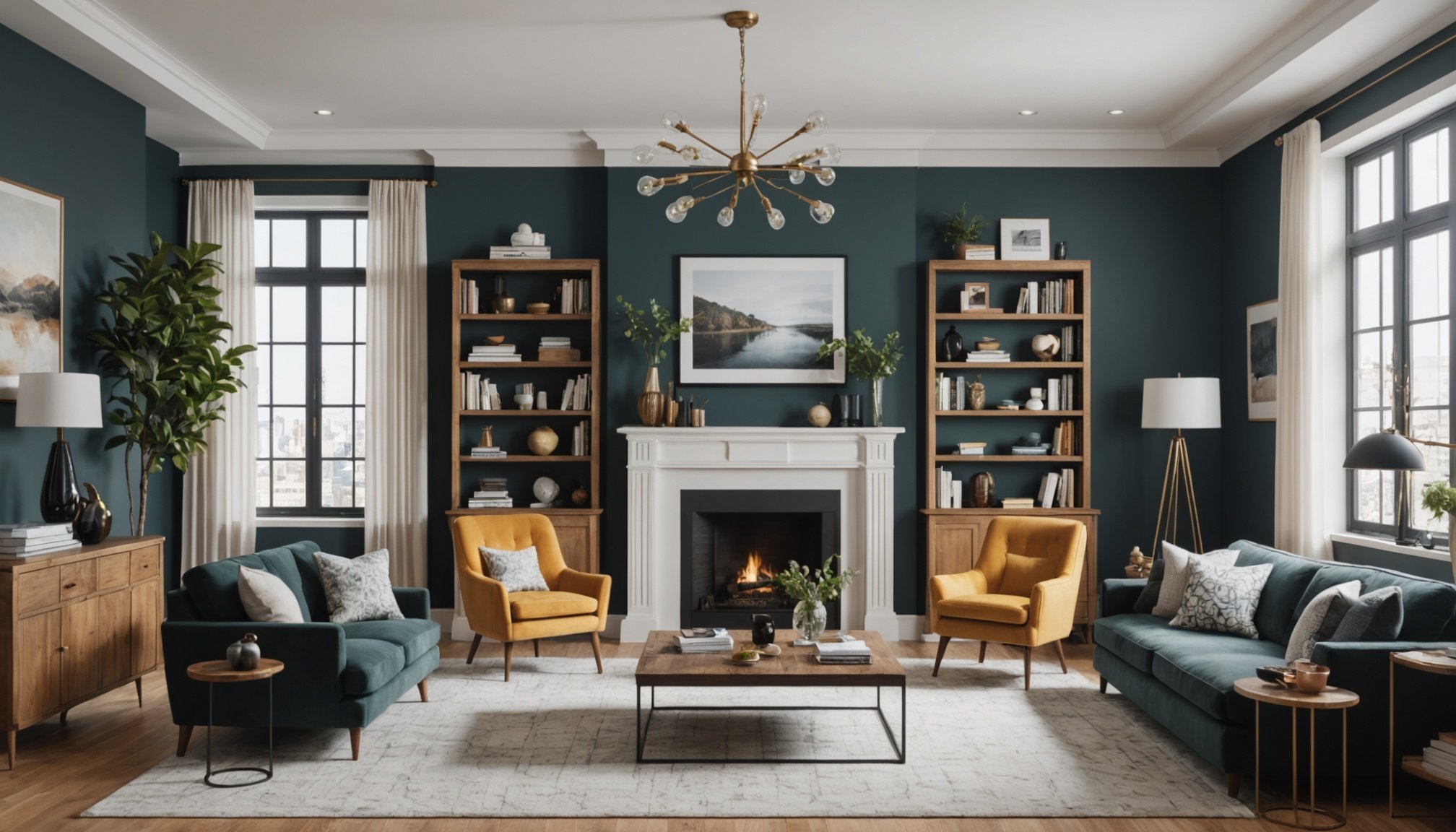Innovative Interior Design Strategies for 2024
In 2024, interior design trends are poised to transform contemporary spaces with a mix of both minimalism and maximalism. Understanding their roles is crucial. Minimalism emphasizes simplicity, removing clutter to focus on function, whereas maximalism embraces bold choices with rich textures and vivid patterns, offering a more dramatic flair. This dual approach allows for personalized aesthetics, catering to diverse tastes.
The influence of color psychology cannot be understated in crafting effective design environments. Colours impact mood and perception dramatically. Cool tones like blues are calming, ideal for relaxation spaces, whereas warm hues invigorate, suitable for social areas. Designers increasingly tailor palettes to evoke specific emotions, enhancing occupant well-being.
Have you seen this : Cutting-Edge Home Decor Trends to Keep You Ahead of the Style Curve
Moreover, 2024’s design integrates organic forms and natural materials to foster a sense of harmony with nature. Curved lines and shapes inspired by the environment create fluidity in interiors, while materials such as wood, stone, and clay increase tactility and rootedness. These elements not only add aesthetic beauty but also promote sustainable living by reducing reliance on synthetic substances. Embracing organic design fosters unique spaces that resonate with ecological balance and timeless beauty.
Sustainable Practices in Future Design
Sustainable practices are revolutionising interior design in 2024, with a strong focus on incorporating eco-friendly materials. Key trends include the use of reclaimed wood, recycled metals, and bamboo, each offering durability along with sustainability. This not only reduces carbon footprint but also adds a unique aesthetic to designs.
Additional reading : Crafting a Trendy and Inviting Home: Stay Ahead with These Cozy Living Tips
Moreover, the integration of energy-efficient technologies plays a pivotal role in modern homes. Smart thermostats, LED lighting, and solar panels are increasingly popular, facilitating significant energy savings. The benefits extend beyond cost efficiency; these technologies also enhance the comfort and customisation of living environments.
Biophilic design further complements sustainable practices by creating symbiotic relationships with nature. It involves incorporating natural elements such as indoor plants and natural light, boosting residents’ well-being and aesthetic appreciation. Biophilic spaces are shown to enhance mood and decrease stress, ultimately contributing to a healthier lifestyle.
These sustainable interior design strategies not only align with environmental goals but also meet the growing demand for spaces that support green living. As consumers become more conscious, adopting such practices ensures a future where style and sustainability coalesce seamlessly, setting the standard for future interior aesthetics.
Technology Integration in Interior Spaces
Integrating smart home technology into interior design offers unparalleled convenience and efficiency. Devices such as smart thermostats, automated lighting systems, and intelligent assistants streamline daily tasks, enhancing the overall quality of life. These systems learn user habits, offering tailored solutions for a more comfortable living environment.
Remote working has reshaped home office design. The trend toward creating dedicated, efficient spaces at home ensures productivity without sacrificing style. Emphasising ergonomic furniture and soundproofing solutions, these spaces blend seamlessly into residential aesthetics while supporting professional needs.
Augmented reality plays a crucial role in revolutionising virtual design consultations. It enables designers and homeowners to visualise changes before implementation, reducing uncertainty and enhancing decision-making. With AR, clients can explore different layouts and styles in a simulated environment, making the design process interactive and precise.
As technology continues to evolve, its integration within interiors not only facilitates modern living but also anticipates future lifestyle demands. Embracing these digital interior solutions equips homeowners with adaptable spaces that cater to dynamic preferences and emerging trends. This synergy between technology and design epitomises the progressive transformation of interior spaces for 2024 and beyond.
Visual Inspiration and Practical Examples
Discovering design inspiration plays a crucial role in translating visions into reality. Successful case studies showcase how design principles yield transformative results in various interior spaces. An impressive example includes the adaptive reuse of old warehouses into chic, liveable lofts that balance industrial charm with modern amenities. Such projects inspire innovative thinking and demonstrate the potential of blending functionality with aesthetic value.
Visual mood boards are invaluable tools, consolidating emerging trends and color palettes in a cohesive manner. These boards often highlight soft earthy tones combined with vibrant accents, offering a visual feast that sparks creativity. Utilizing layers of texture and complementary hues, mood boards provide a tactile sense of different styles, from rustic farmhouse to urban industrial.
Adaptable spaces are the future of interior design, accommodating dynamic lifestyle changes. Multifunctional furniture, like sofas that convert to beds, offers solutions for maximising utility in smaller areas. Open-concept living areas encourage flexibility, allowing spaces to transition easily from peaceful retreats to lively entertainment.
As trends evolve, understanding how to incorporate these visual ideas and practical solutions ensures each design choice is purposeful and impactful, paving the way for personalised living environments that adapt to the times.
Expert Insights on Future-Forward Design
Professional insights from leading interior designers shed light on navigating the evolving landscape of interior design. Renowned experts emphasize the importance of blending interior design expertise with contemporary trends to create spaces that are both innovative and timeless. In an interview, design consultant Sarah Monroe highlights the critical role of understanding clients’ personal styles and environmental concerns in crafting bespoke designs.
When adopting new trends, avoiding common pitfalls is crucial. Interior design often falls into the trap of over-embellishment or neglecting functionality. To counter this, experts suggest maintaining a balance between bold aesthetics and practical utility. Designer John Ellis advises integrating design consultation to ensure that choices align with both aesthetics and lifestyle needs.
To make bold design choices, actionable tips from professionals include starting with a focal piece, such as a distinctive art piece or a unique furniture item. This centerpiece can guide other design choices, ensuring cohesion and impact. Elevating the interior design expertise in your home guarantees that each element is considered and purposeful, ultimately enriching the living experience. By adhering to expert recommendations, design becomes an adaptable, forward-thinking practice.
Preparing for Future Lifestyle Needs
In 2024, interior design is profoundly shaped by future living spaces that reflect evolving lifestyle trends. As demographics shift, design preferences increasingly favour adaptable design to accommodate varied needs. An emphasis on multi-functional spaces emerges, as modern homes now require areas that can effortlessly transform between purposes. For instance, a living room that becomes a guest room or a dining area that morphs into a workspace demonstrates the flexibility demanded by contemporary households.
Moreover, designing for wellness and comfort is paramount. Designers now prioritise elements that promote mental and physical well-being, ensuring that interiors provide refuge from daily stresses. Thoughtful layouts harness natural light and incorporate ergonomic furniture to enhance living conditions.
Understanding demographics is crucial. As households diversify, including both younger professionals and older adults, interior design must cater to different lifestyle expectations. Multi-generational living solutions, such as accessible bathrooms and inclusive kitchen designs, are becoming standard.
Innovative designers adapt to these lifestyle trends by proposing dynamic solutions that blend functionality with aesthetic appeal. This ensures that interior spaces not only meet current demands but also anticipate future shifts in living preferences, thereby securing comfort and satisfaction for all occupants.



